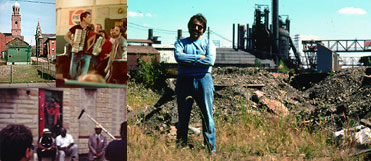 |
|
|
|
One of Buba’s first film portraits, J. Roy–New and Used Furniture (1974), follows a man who has had 11 failed businesses but now feels that he can finally make it with a cluttered second hand shop. Despite his failures, we see J. Roy lecturing his staff about the secrets to success, and we hear his ambitious plans to install a drive-in used car lot upstairs. We see him in a tuxedo, expecting 2000 people for the grand opening featuring a ribbon cutting ceremony with the Mayor, but only the Mayor shows up. Sweet Sal (1979) follows a charismatic ex-numbers runner, Sal Caru, who conveys a tough guy persona for the camera, but this charade ends at the end of the film when he visits his father’s grave. Buba portrays both J. Roy and Sal with humor and respect, as they both reflect the American Dream and the economic circumstances in Braddock. And just as Buba’s relationship with Braddock has continued over the years, the subjects of his films also re-appear in later films. Both J. Roy and Sal appear in Lightning Over Braddock, in which Sal claims that he “made” Buba through the success of Sweet Sal. One reason for Sal’s claim is due a particularly fortuitous screening of Sweet Sal in 1979, when renowned German filmmaker Werner Herzog was in Pittsburgh for a retrospective at The Carnegie. Herzog had agreed to spend some time looking at the work of local filmmakers, and he responded very strongly to Buba’s Sweet Sal. “Do you have any more? I want to see everything you’ve made” Herzog reportedly demanded. Herzog has since been one of many strong advocates for Buba’s work, but even before this meeting Buba’s films had been winning awards and citations at documentary film festivals across the country. Buba earned an MFA in film production from Ohio University in 1976, and worked as a sound recordist on horror films by Pittsburgh native George Romero (Martin, Dawn of the Dead). This allowed Buba to stay relatively close to home and to continue exploring Braddock as a subject for his films. “I didn’t start out with this whole idea of chronicling Braddock,” he explains, “It just became something that happened.” In 1978, he was hired as a visiting professor at the University of Southern Illinois–Carbondale, and since then has also taught at Ohio University, Edinboro University of Pennsylvania, and Pittsburgh Filmmakers. In 1983, Buba completed Voices from a Steeltown, his first extended analysis of the economic history of Braddock. Braddock had been a “boom town” when Andrew Carnegie opened his first steel mill there, and it became thriving cultural and commercial center. “What Braddock Makes the World Takes” became the town’s slogan. But now Braddock was going bust, and its remaining residents were trying to figure out what happened. “This is personal filmmaking at its best...and it is socially conscious filmmaking at its best,” critic Pat Aufderheide wrote, “Buba’s camera picks up the symbols and ruins of the community, as well as putting in the center of the picture Braddock residents struggling to comprehend and cherish their past and to build a future.” Voices from a Steeltown aired on PBS stations on a regional basis, further expanding Buba’s audience. In 1985, Buba received the Hazlett Award for Pennsylvania Media Artist of the Year, which acknowledged his growing body of work. He also found support for his new projects through a Guggenheim Fellowship and a National Endowment for the Arts Fellowship in the Media Arts. His new projects found new audiences and wider exposure. His short Braddock Food Bank (1985) toured with the Black Maria Film Festival and aired on the prestigious documentary series P.O.V. on PBS. This support also led Buba to his most ambitious project to that point, the feature length Lightning Over Braddock: A Rustbowl Fantasy, in 1988. Buba describes the film as “a parodic fusion of social documentary, autobiographical dilemma, and whimsical fantasy woven into a fictionalized story line.” At the heart of the film, Buba reflects on the irony that his fortunes as a filmmaker rose because of Braddock’s decline. He also traces his strained relationship with Sal Caru through a fictionalized storyline about a possible feature film deal starring Sal with Buba directing. Meanwhile, the film also documents the real life drama of the USX Company’s closing of the Dorothy Six steel mill in Braddock. “I mixed fiction and documentary because I wanted the viewers to be in doubt about what was real and what wasn’t, instead of just sitting there being a good consumer,” Buba explained, “I wanted the audience to be annoyed with me. I wanted the audience to ask ‘Why isn’t he doing more on the important issues, why does he want to make a Hollywood film?” Lightning Over Braddock was featured at the Toronto International Film Festival and the Sundance Film Festival, and it was nominated for Best First Feature Film at the Independent Spirit Awards. It has also been broadcast on Bravo and the Sundance Channel. Buba ventured into fiction filmmaking with No Pets in 1994, an adaptation of a short story by Michigan-based writer Jim Daniels. The tagline for the film, “A Post-Industrial Romance,” signals to the viewer that Buba will still explore issues relevant to the working-class, as the film is based upon Daniels’ experiences on the job at an automobile production plant. When No Pets played at the London Film Festival, Trevor Johnson at Time Out called the film, “a perceptive, unpatronising and compassionate study of an ordinary blue collar worker...There’s no false promises or fake uplift here, just a well observed stare in the face of uncomfortable truths.” Buba’s most recent feature length documentary project, Struggles in Steel: A Story of African-American Steelworkers (1996), began when Buba’s friend Raymond Henderson saw a television documentary on unemployed steelworkers. As a former mill grievance man and NAACP chapter president, Henderson was outraged that he saw no African-Americans telling their story in the documentary, so he approached Buba about the possibility of making their own film. Even before collaborating with Buba, Henderson had collected oral histories from black steelworkers in the hopes of documenting their vitally important contributions to the American steel industry. “We originally planned to do a half-hour documentary,” Buba explained, “but we became more ambitious when middle-age med began crying on camera talking about their experiences.” Buba and Henderson were able to expand the scope of the film when the Independent Television Service awarded them a grant after seeing a 12-minute version of the material that Buba had edited. The film introduces us to many hard working and dedicated African-American men and women who were not allowed to advance in the mills due to the color of their skin. “We wanted to show real role models,” Henderson said, “While the media wants to present athletes or entertainers as our role models, the real role models were our fathers and mothers who worked hard every day.” By allowing these men and women to tell their own stories, Buba and Henderson do more than simply convey the facts about this history. We also see the passion, anger, frustration, and dignity with which these workers struggled to make things better for themselves and their families. “More than anything, Ray wanted to show folks that the elderly, sometimes broken men you see walking around town paved the way with their suffering and patience,” Buba observed. After the completion of Struggles in Steel, Buba was awarded Artist of the Year by the Pittsburgh Center for the Arts in 1998. He also received the Alfred I. DuPont-Columbia University Award for Excellence in Broadcast Journalism in 1999. Struggles in Steel was featured at several important film festivals including Sundance, and it has aired on the Sundance Channel and PBS. Buba’s residency is sponsored by the Department of Communication Arts in collaboration with the Creative Writing Program in the Department of English, the School of Journalism and Mass Communication, and Wisconsin Public Television. In the Fall 2001 semester, Buba will teach two filmmaking courses, "Documentary Video: Exploring Wisconsin Life" and "Personal Documentary Film & Video Workshop." Just as Buba has explored his hometown of Braddock, both of these courses will encourage students to find their own voice by asking questions about their experiences in Wisconsin, and to develop their journalistic and creative skills in the process. Buba will also present public screenings of his work, and participate in outreach activities with participating departments and Wisconsin Public Television. --James Kreul |

